
Barbican, London
13 February – 26 May 2024
by BETH WILLIAMSON
From birth to death, textiles are an intricate part of our lives. They provide clothing, protection, warmth and comfort. The question at the heart of this exhibition is one all the artists here have grappled with in different ways. What they have in common is that they have all engaged with the question of how textiles can be used as a tool for resistance, to reshape and reimagine the world around us. The idea of the power and politics of textiles in art is explicit in the exhibition’s title and is borne out in every artwork displayed as part of this formidable show. Picking up on art and textile’s many histories and metaphors, the exhibition structures the work of 50 artists and about 100 works across six themes.
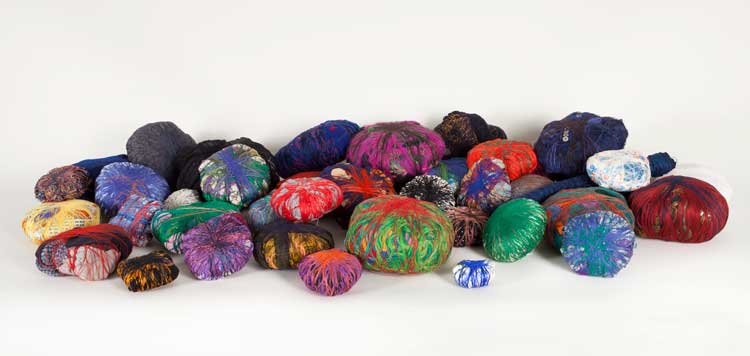
Sheila Hicks, Family Treasures, 1993. © Sheila Hicks, ADAGP, Paris and DACS, London 2023, courtesy Stedelijk Museum Amsterdam.
The exhibition opens with “Subversive Stitch”, firmly anchoring itself in art historian Rozsika Parker’s 1984 book of the same name. Parker’s motivation for the book was to examine why textiles were so often dismissed as “women’s work” and how, despite this, women have used textiles for subversion and resistance. This exhibition expands on Parker’s ideas by including multiple generations and genders of artists. In the 1980s, the Egyptian artist Ghada Amar (b1963) was not permitted to enrol in a painting class at art school because she was a woman. In a direct challenge to this, she uses embroidery with its feminine associations to make a work that gestures to the traditionally masculine act of painting. The work of Lebanese artist Mounira Al Solh (b1978) combines ink and embroidery in Paper Speakers (2020-21), made in response to protests that took place in Lebanon in 2015 amid growing economic crisis and leading to revolution in 2019.
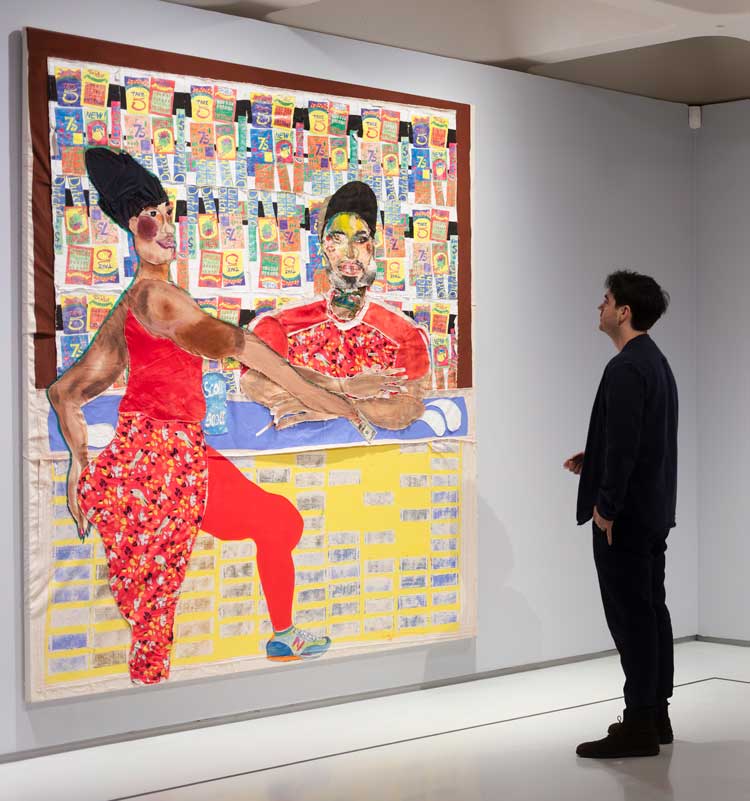
Tschabalala Self, Koco at the Bodega, 2017. Installation view, Unravel: The Power and Politics of Textiles in Art, Barbican Art Gallery 13 Feb – 26 May 2024 © Jemima Yong / Barbican Art Gallery
Moving into the “Fabric of Everyday Life”, the exhibition picks up on how embedded fabric is in our everyday lives, the good and the bad, the pleasurable and the painful. Family Treasures (1993) is an intensely personal work by Sheila Hicks (b1934). The artist asked friends and family to donate their most treasured item of clothing to her. Each item was tightly wrapped in colourful yarn and thread as a reminder of what we hold dear. The American artist Tschabalala Self (b1990) interrogates “how a body is consumed, how a body is experienced and how a body is inhabited”. In Koco at the Bodega (2017), she interrogates the experience of living in a black woman’s body and celebrates the bodega as a site of community.
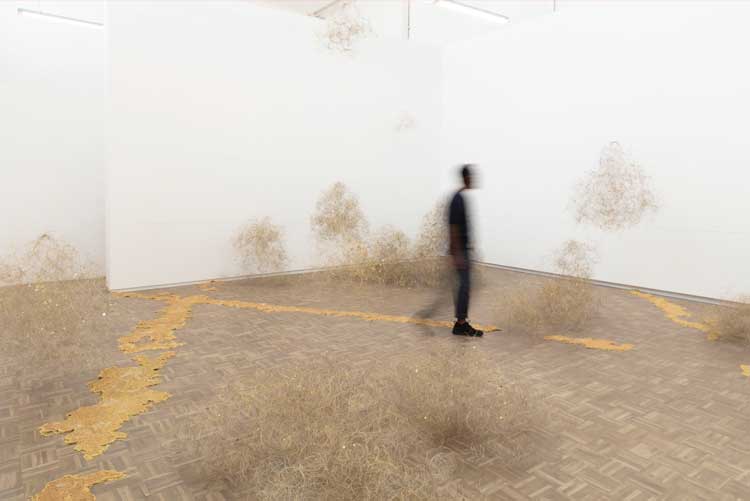
Igshaan Adams, Gebedswolke (Prayer Clouds), 2021–23. © Igshaan Adams, courtesy the artist and blank projects, Cape Town.
The “Borderlands” of experience are the subject of the next section of this exhibition. It takes its idea from the American scholar Gloria E Anzaldúa, who described the borderland as a “vague and undetermined place created by the emotional residue of an unnatural boundary”. The gossamer weave of work by South African artist Igshaan Adams (b1982) is poignant, atmospheric and simply beautiful, despite the complex and painful stories it tells of race, religion and sexuality. Work by the Sri Lankan-born artist T Vinoja (b1991) is very different from that by Adams. In Bunker & Border and The Day, both from 2021, Vinoja uses stitching to explore the effect of the decades-long Sri Lankan civil war (1983 to 2009), especially in terms of loss of life, disability and displacement. The cartographic works of the Filipino artist Cian Dayrit (b1989) are tools for investigation into the imperial power and control they help to impose. In Valley of Dispossession (2021), the artist shows how practices of extraction have destroyed land and communities in the Central Luzon region of the Philippines.
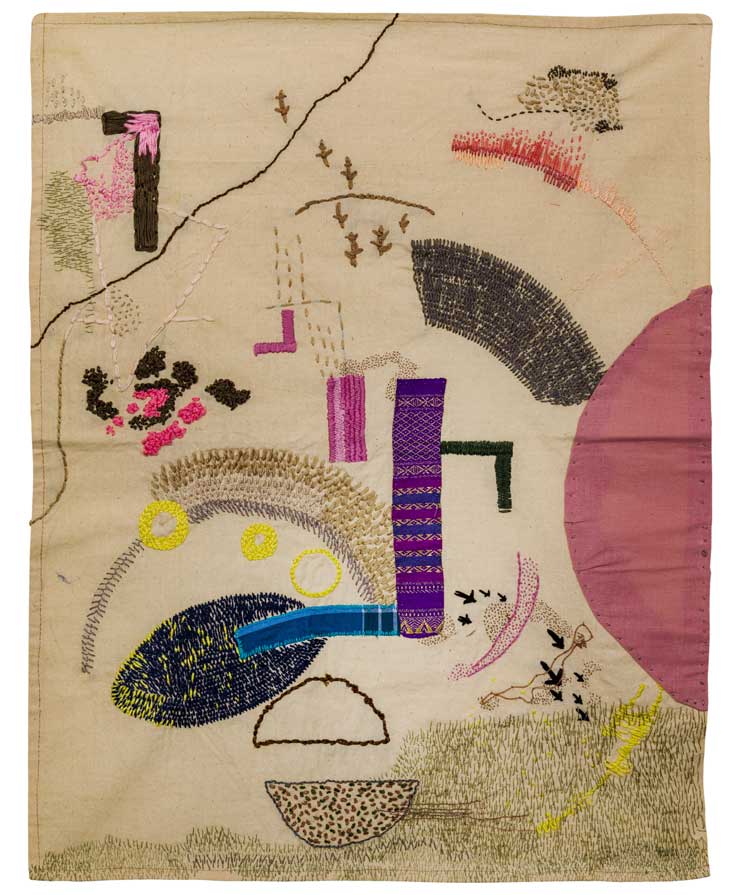
T. Vinoja, Bunker & border, 2021. Courtesy the artist and Experimenter.
Under the umbrella of the exhibition’s fourth theme, “Bearing Witness”, a number of artists do just that, using textiles to document or protest against political violence and turning them into memorials to the victims of oppression while acting as a right of reply to positions of power. The Indian artist Zamthingla Ruivah (b1966) hand wove a woollen sarong, Luingamla Kashan (1990-ongoing). Luingamla, a friend of the artist, was murdered by army officers who attempted to rape her. It took four years to get justice and this textile piece commemorates the young woman’s path to some sort of justice. Work by the Norwegian artist Hannah Ryggen (1894-1970) addresses the atrocities of the Vietnam war (1955-75). The Mexican artist Teresa Margolles (b1963) is in search of the missing in her work as she commemorates the lives of murder victims in the work shown here – two patchwork tapestries that “carry the impressions and memories of bodies lost as a result of violence”. It is powerful stuff.
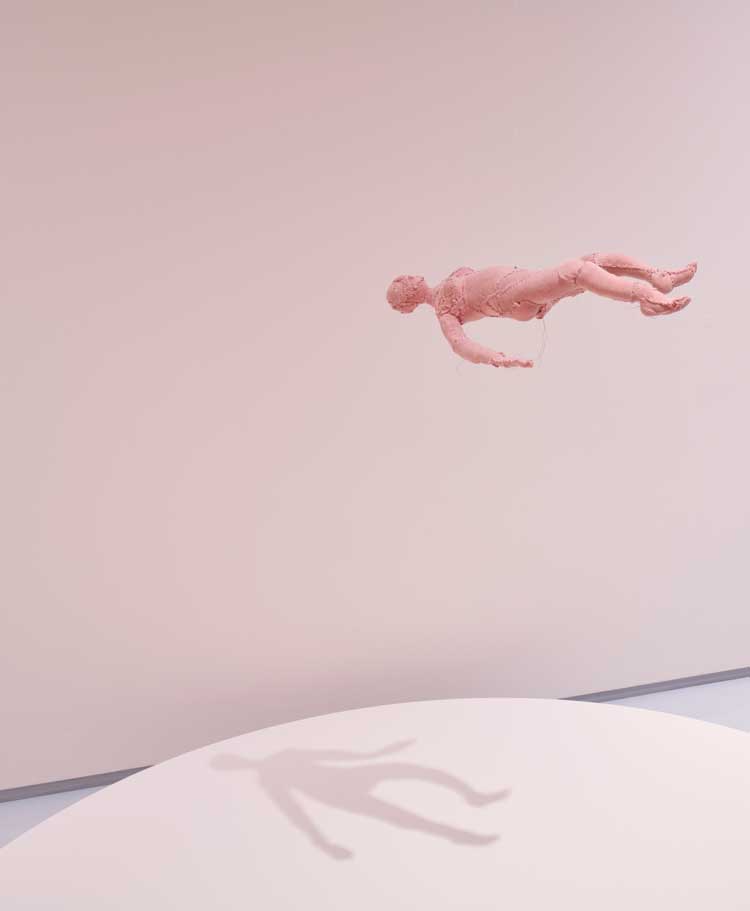
Louise Bourgeois, Arch of Hysteria, 2000. Installation view, Unravel: The Power and Politics of Textiles in Art, Barbican Art Gallery. © Jo Underhill / Barbican Art Gallery.
What can humankind do in the face of the multiple enormous crises faced by the world today? From climate change and the ecological crisis, to political and economic crises to the atrocities of war, what can be done to heal the wounds inflicted by these situations? “Wound and Repair” takes on that huge question in the work of artists who seek to somehow repair the damage. Hong Kong artist Angela Su (b1969) shows three works from her Sewing Together series, made in response to the pro-democracy protests in Hong Kong in 2019. The effects of state violence on mind are body are explored through embroidered images of the suturing of a vulva, and the piercing of an eye and a breast. She embroiders with hair, not thread, adding a further layer of bodily and feminine reference. Arch of Hysteria (2000) by Louise Bourgeois (1911-2010) uses a textile doll or model to convey a psychic experience of pain.
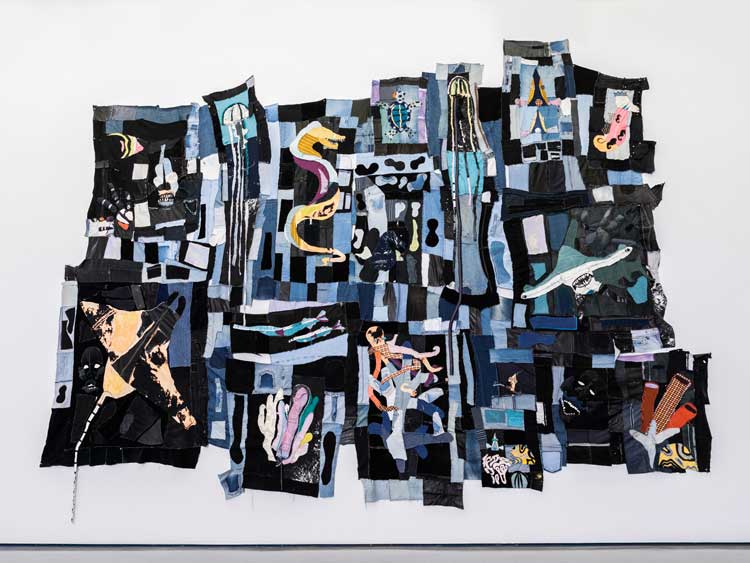
Tau Lewis, The Coral Reef Preservation Society, 2019. © Tau Lewis, courtesy the artist and Night Gallery, Los Angeles.
“Ancestral Threads” is the final and largest section of the exhibition and includes a wide range of artists who explore the layered histories of textiles to tell stories of empire, trade, extraction, enslavement and much more. Looking to their own ancestors, or those of other communities, for inspiration, these artists produce widely different works in response to those histories, but always in textiles of one sort or another. Canadian artist Tau Lewis (b1993) uses recycled fabrics and seashells in The Coral Reef Preservation Society (2019), partly in homage to enslaved people who lost their lives in the Middle Passage, a stage of the Atlantic slave trade. Quipu Austral (2012), a monumental work by the Chilean artist Cecilia Vicuña (b1948) comprising lengths of unspun wool and sound, was made as a “prayer for the union of the world”.
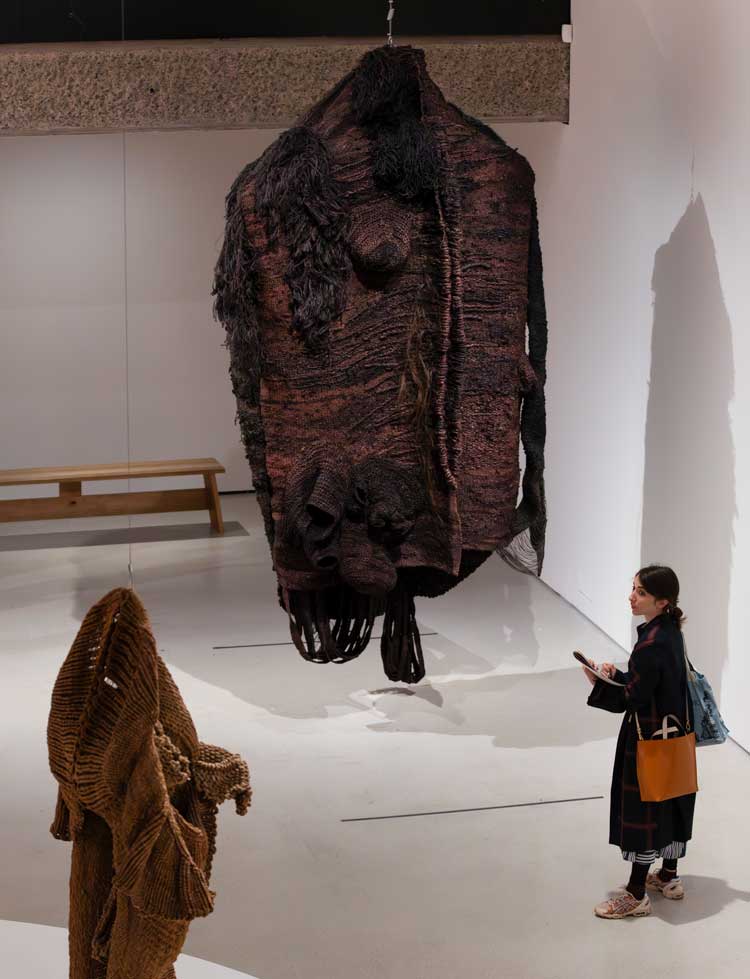
Centre: Magdalena Abakanowicz, Vêtement Noir (Black Garment), 1968. Installation view, Unravel: The Power and Politics of Textiles in Art, Barbican Art Gallery. © Jemima Yong / Barbican Art Gallery.
The fibrous structures of works by Magdalena Abakanowicz (1930-2017) create sculptural environments that nonetheless embrace the vernacular traditions of textiles. Also embracing the expressive potential of natural fibres are three earthy bodies of dyed hemp by the Indian artist Mrinalini Mukherjee (1949-2015). Twisting and knotting ropes found in local markets, Mukherjee created forms or beings in line with her vision of “sculpture as a kind of organic unfolding”. From hemp and sisal to cotton and silk, from the personal to the community, from the injustices of the world to the power and politics of textiles in art, it is a potent medium. Individually, these artists are formidable tellers of stories that need to be told, retold and remembered. Collectively, in this exhibition, it is a reminder of what can be done and how resistance can sometimes unravel in the most unlikely of ways.
Christian Krohg: The People of the North
A key figure in Norwegian art, naturalist painter Christian Krohg wanted his art to bring social cha...
This comprehensive show charts the groundbreaking rise of the illustrated poster in 19th-century Fra...
Caspar David Friedrich: The Soul of Nature
This comprehensive show celebrating last year’s 250th anniversary of the Romantic painter’s birt...
A humongous survey of contemporary painting in Belgium shows a medium embracing the burden of its hi...
A retrospective of the first 20 years of the Max Mara Art Prize for Women finds an inexhaustible wel...
This new work is very much about indeterminate selfhood as Nora Turato immerses the visitor in a swi...
Burmese artist Htein Lin has been jailed many times and this show includes some of the remarkable pa...
This retrospective brings the acclaimed and trailblazing, but nearly forgotten French modernist arti...
Mainie Jellett and Evie Hone: The Art of Friendship
A kaleidoscope of colour through which the history of modernism is refracted, this exhibition brings...
In this major retrospective, the viewer is like an avatar navigating the humans – real and CGI –...
Sharjah March Meeting 2025: To Carry Songs
Sharjah Art Foundation’s annual symposium this year explored how culture is preserved and shared w...
Christopher Le Brun & Charlotte Verity – interview: ‘There is such a t...
To coincide with a rare joint exhibition now on view at The Gallery at Windsor in Florida, Christoph...
Valentina Karga highlights the ecological horrors ravaging our world, but her aim is not to shock or...
Peter Mitchell: Nothing Lasts Forever
Peter Mitchell’s photographs of urban decay and the demolition of buildings in Leeds over the past...
Lee’s headless heroines and canines are the fifth of the Met’s Genesis Facade Commissions. But w...
Lina Lapelytė – interview: ‘Between this group of performers, what we...
Perhaps best known for her eco-opera Sun & Sea (Marina), Lina Lapelytė discusses her approach to im...
Spanning four centuries and diverse cultures, this show of more than 7o works, including paintings, ...
With highlights from the Courtauld’s collection of German and Austrian modernist works on paper an...
Louise Bourgeois, Sheida Soleimani and Gillian Wearing are among the 30 female artists contributing ...
In this mind-blowing and dazzling exhibition, Rafał Zajko takes us into a mysterious realm of art a...
Mahtab Hussain: What Did You Want to See?
With portraits of mosques and people at prayer, British Asian photographer Mahtab Hussain documents ...
The Cosmos of “Der Blaue Reiter” – From Kandinsky to Campendonk
This show retraces the roots of the expressionist artists who made up the Blue Rider group, looking ...
Celia Paul: Colony of Ghosts* and Celia Paul: Diaries**
Two concurrent solo exhibitions paint a much broader portrait of the artist Celia Paul, debunking th...
Edvard Munch’s portraits have flown under the radar, but getting to know his sitters reveals a lot...
In her films, sculptures, tapestries and prints Yto Barrada plays with the materiality of colour...
Delaine Le Bas – interview: ‘People still have expectations about what...
From the heart of her installation at the White House in east London, Romany artist Delaine Le Bas t...
Olivia Bax – interview: ‘With art, there are so many unwritten rules a...
Sculptor Olivia Bax talks about curating These Mad Hybrids: John Hoyland and Contemporary Sculpture,...
Astonishing Things: The Drawings of Victor Hugo
The Royal Academy of Art’s new exhibition reveals the mighty French novelist as a fascinating, eve...
Symbiosis: Art in the Age of AI
The exhibition presents a gamut of international artists who work with artificial intelligence in va...
Siena: The Rise of Painting, 1300-1350
The National Gallery’s meticulously researched exhibition of medieval Sienese masterpieces is an a...